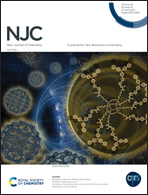The bimetallic and the anchoring group effects on both optical and charge transport properties of hexaphyrin amethyrin†
Abstract
In the present work, we performed a theoretical study at the density functional theory (DFT) level of both optical and charge transport properties in a series of molecular junctions consisting of an expanded porphyrin such as hexaphyrin (1.0.0.1.0.0) named amethyrin (free base FB) and its Zn(II)- and Cu(II)-bimetallic derivatives with four different anchoring groups (ethyl, phenyl, ethynyl, direct). After a calibration procedure with five density functionals, the electronic absorption spectra were computed (TPSSh/def2-TZVP) with time-dependent DFT (TD-DFT). The bimetalation produces a decrease in both Q and Soret bands’ intensity and a red-shift in the absorption. Still, the effect is more significant for the singlet Cu(II) systems where the Q bands are shifted to near-infrared (∼900 nm). It means that they could be attractive for solar cells by the absorption at the longest wavelength. DFT and wavefunction-based calculations for the coupling constant (J) demonstrated a ferromagnetic behavior for Cu(II) systems, which is coherent with the higher stability of the Cu(II) triplet compared to the singlet. The differential conductance and the I–V profiles of each system are calculated using DFT and nonequilibrium Green's function (NEGF) formalism to rationalize the charge transport mechanisms. It was found that the conductance does not drastically change with both Zn(II) and Cu(II) metalation, being larger for the latter, but it is strongly dependent on the anchoring group (ethyl < phenyl < ethynyl < direct). In Cu(II) bridge junctions, in both high and low spin configurations, the antiferromagnetically coupled systems exhibit an increase in conductance compared to the ferromagnetic ones. The important difference (around 100–200%) in the total current calculated between the triplet and the singlet configurations with ethynyl, for the voltage range of 0.1–0.5 V, suggests that Cu(II)-amethyrins could have applications as a molecular switch operated by the application of an external magnetic field.



 Please wait while we load your content...
Please wait while we load your content...